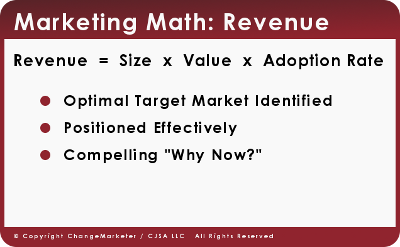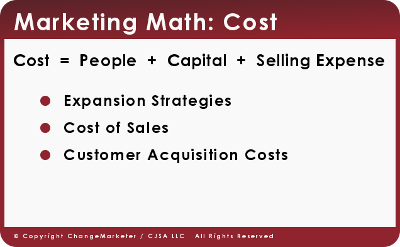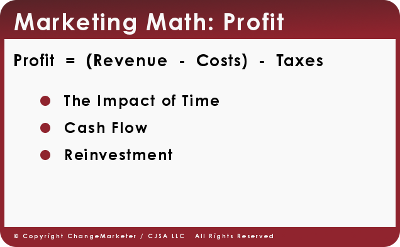It all adds up with a compelling “Why Now?”

New products get launched using the most expensive selling resources: sales people and founders. This is essential for creating initial traction, but is not scalable when growth becomes the goal. Effective marketing based on realistic math is what makes it all add up.
Recap
This is a thread about How to Leverage the Marketplace Forces that Matter Most for Business Growth. Eight crucial marketplace forces have been identified and are being explored in depth in this series.
What is Realistic Marketing Math?
Realistic marketing math is the equations, forecast, and performance data, that address profitability by bringing together volume, time and money.
In a nutshell:
- Revenue: Size x Value x Adoption Rate
- Cost: People + Capital + Selling Expense
- Profit: (Revenue – Costs) – Taxes
Each marketplace force has financial ramification. Links to previous posts are being included as we use marketing math to tie them all together and close this series.
Revenue: Closing the Gap between Projection and Performance
Revenue is forecast based on the size of the market targeted (people, companies and/or organizations), the price of the product/service (based on value in comparison to the alternatives) and the speed at which the prospect will purchase (adoption rate).

Realistic marketing math goes deeper by recognizing:
- Time is the enemy. Many businesses have floundered by misjudging the rate of adoption. Generating awareness, supporting the case for action, and establishing new habits, takes time and money. Having a compelling “Why Now?” is the best offensive action an emerging company has to speed adoption. For a more detailed discussion see Market Force #1: “Why Now?”
- Prospects are not equal. There is a smaller optimal target market where forces are at work that help push prospects towards a buying decision. For a more detailed discussion see Market Force #2: “Why Me?”
- Value is contextual. The prospect always has an alternative, including doing nothing. Understanding who or what you are competing against in the mind of the prospect is vital to being positioned effectively and priced appropriately. For a more detailed discussion see Market Force #3: “Why This Product?”
Revenue is realized when a prospect purchases. Realistic marketing math helps in closing the gap so often seen between projections and performance. It also speed customer adoption and revenue generation.
Cost: Achieving Scalable Selling Strategies
A CFO friend shared the “rule of 25” as a way to think about a profitable software business. Here’s how it works. Budget 25% of revenue for each of the following:
- Sales and Marketing Expenses
- Product / Technology Expenses
- Overhead / Facilities / Equipment
- Profits
In start-ups, before profitability is achieved, sales and marketing can be over 3,000% of revenue. However, the “rule of 25” helps to visualize where your selling strategies need to be heading in order to be profitable. Even if profitability initially takes a back seat to securing market share, that can’t last forever.

Realistic marketing math goes deeper by recognizing:
- Change takes time and money to achieve. This means understanding what the true cost of educating your market is likely to be. Looking at appropriate comparables can help range the anticipated costs. For a more detailed discussion see Market Force #4: “Behavioral Evidence?”
- Clarity in communicating value affects costs. All too often sales teams are unleashed with murky messaging as to how their product delivers value. This means valuable time and plenty of money gets wasted. Starting with clear messaging, before ramping up sales, can lower the cost of sales. For a more detailed discussion see Why Me? Why Now? Why This Product?
- It’s a two-way street – selling and buying. What you want to sell and how you sell it is only half the equation. What the customer wants and how they want to buy is the other half. Alignment is needed to avoid a crash. For a more detailed discussion see Market Force #6: “Aligned with Needs?”
Realistic marketing math helps in ensuring your “runway” is long enough to achieve take-off. It also helps you identify critical tasks and timelines so resources can be effectively focused.
Profit: (Revenue – Costs) – Taxes
As was just explored in the revenue and cost sections, marketing strategy and execution has a tremendous impact on growth and profitability.

Realistic marketing math goes deeper by recognizing:
- Express value clearly, concisely and competitively. For a more detailed discussion see Market Force #5: “Positioned Clearly?”
- Apply Systematic-Marketing. To realize a payback that is cumulative, not episodic. For a more detailed discussion see Market Force #7: “Practicing Systematic-Marketing?”
- Leverage the market forces that matter most for growth. By focusing on the forces capable of influencing buying behavior. For a more detailed discussion see Eight Marketplace Forces
Realistic marketing math works to fast-track growth and profitability. It also helps to minimize the number of “redo” cycles start-ups typically experience while attempting to gain traction.
Closing: Business Growth
This is the last post in the series How to Leverage the Marketplace Forces that Matter Most for Business Growth. Eight crucial marketplace forces have been identified and explored in depth and are recapped below. The goal has been to help you think about additional steps you can take for business growth.


